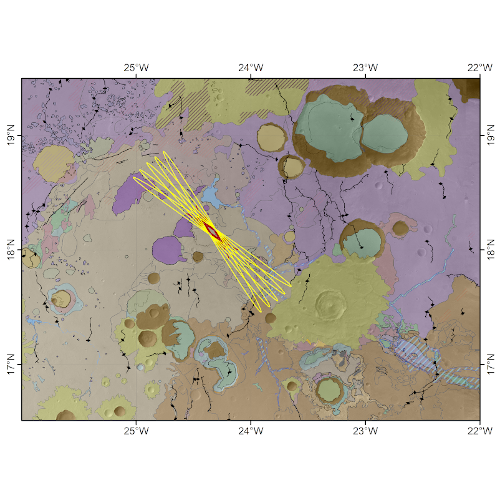Regional Geologic Mapping of the Oxia Planum Landing Site for the Exomars Mission
- 1DLR, Institute of Planetary Research, Berlin, Germany (ernst.hauber@dlr.de)
- 2Universität Potsdam, Germany
- 3Freie Universität Berlin, Germany
The ExoMars mission will deploy a stationary surface platform and a rover in Oxia Planum (OP), a region at the transition between the heavily cratered highlands of Mars and the ancient and filled impact basin, Chryse Planitia. While the fundamental geologic characteristics of the area have been investigated during the landing site selection process, detailed geologic or morpho-stratigraphic mapping is still missing. To fill this knowledge gap, two complementary mapping approaches were initiated by the ExoMars RSOWG: (1) Local HiRISE-scale mapping of the landing ellipse(s) area (reported elsewhere: Sefton-Nash et al., LPSC 2020). (2) Regional mapping at ~CTX-scale [this study] will provide a more synoptic view of the wider landing site within OP, enabling the contextualization of the units within the stratigraphy of western Arabia Terra and Chryse Planitia, and a comparison to other sites with similar key geologic and physiographic characteristics. It is also expected that this map will serve as a geologic reference throughout the mission and subsequent data analysis. The study area is located between 16.5°N and 19.5°N, and 334°E to 338°E. The data sets used for mapping include HRSC, THEMIS IR (day and night), CTX, and CaSSIS. Mapping scale in a GIS environment is 1:100,000, which will result in a final printable map at a scale of 1:1M.
Mapping started in mid-October 2019. Overall, the identified map units are very similar to those described by Quantin et al. (Astrobiology, submitted): The spatially most widespread units are the phyllosilicate-bearing unit that is the prime ExoMars target (with distinctly enhanced THEMIS nighttime temperatures when compared to its surroundings), a dark resistant unit of possibly volcanic or sedimentary origin, and a mantling unit that was likely emplaced by eolian processes. Multiple channels of various morphology and degradation state as well as sedimentary fan-shaped deposits (with low nighttime temperatures) imply a diverse and possibly long-lived history of surface runoff, perhaps accompanied or replaced by groundwater processes such as sapping. Inverted landforms (channels, impact craters) are the result of intense erosion. Additional mapped features include tectonic structures such as wrinkle ridges and lobate scarps (delineating a basin-like depression in the central mapping area), remnant erosional buttes in the northwestern portion of the mapping area (i.e. towards Chryse Planitia), craters and their ejecta blankets, and fields of eolian bedforms and secondary craters.
At the time of writing, the mapping is incomplete (partly cecause of the impact of the covid-19 crisis on the coordination of the joint mapping), and only initial and limited conclusions can be drawn. Overall, the mapping confirms previous geologic analyses. However, some features (e.g., contractional structures, channels, possible sapping landforms) need further attention as the may provide important constraints on the tectonic and aqueous evolution of the ExoMars landing area. A comparison to a distant, but geologically very similar site in Xanthe Terra, southeast of the Hypanis fan-shaped deposits, may enable testing of hypotheses raised by the geologic mapping of Oxia Planum.

How to cite: Hauber, E., Adeli, S., Tirsch, D., Nass, A., Acktories, S., and Steffens, S.: Regional Geologic Mapping of the Oxia Planum Landing Site for the Exomars Mission, Europlanet Science Congress 2020, online, 21 September–9 Oct 2020, EPSC2020-1100, https://doi.org/10.5194/epsc2020-1100, 2020